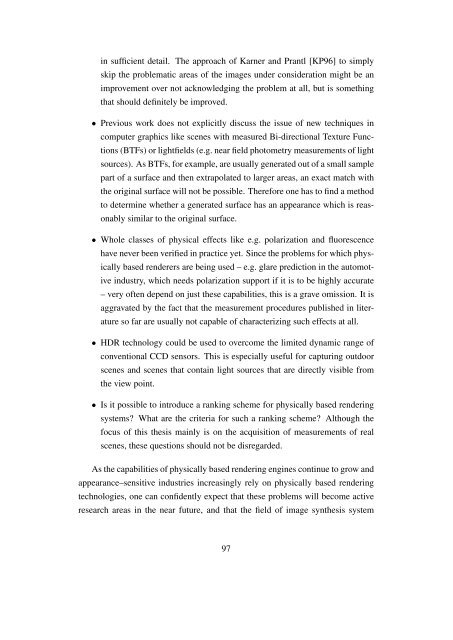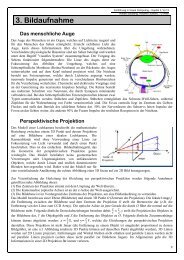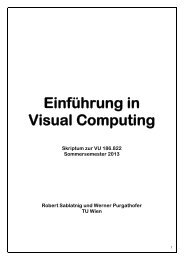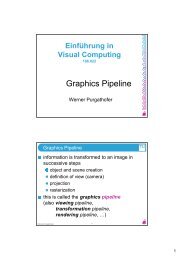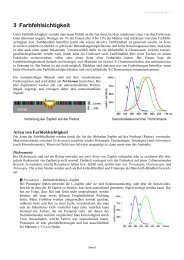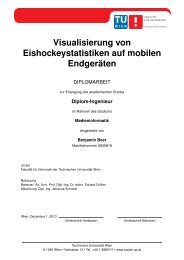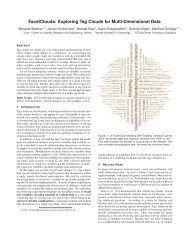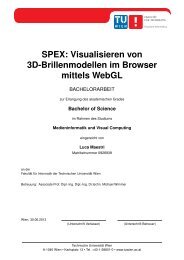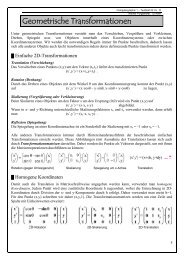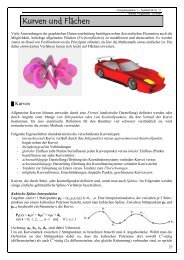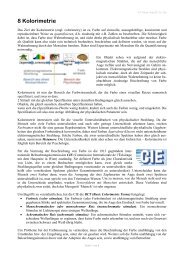Usability of Digital Cameras for Verifying Physically Based ...
Usability of Digital Cameras for Verifying Physically Based ...
Usability of Digital Cameras for Verifying Physically Based ...
Create successful ePaper yourself
Turn your PDF publications into a flip-book with our unique Google optimized e-Paper software.
in sufficient detail. The approach <strong>of</strong> Karner and Prantl [KP96] to simply<br />
skip the problematic areas <strong>of</strong> the images under consideration might be an<br />
improvement over not acknowledging the problem at all, but is something<br />
that should definitely be improved.<br />
• Previous work does not explicitly discuss the issue <strong>of</strong> new techniques in<br />
computer graphics like scenes with measured Bi-directional Texture Func-<br />
tions (BTFs) or lightfields (e.g. near field photometry measurements <strong>of</strong> light<br />
sources). As BTFs, <strong>for</strong> example, are usually generated out <strong>of</strong> a small sample<br />
part <strong>of</strong> a surface and then extrapolated to larger areas, an exact match with<br />
the original surface will not be possible. There<strong>for</strong>e one has to find a method<br />
to determine whether a generated surface has an appearance which is reas-<br />
onably similar to the original surface.<br />
• Whole classes <strong>of</strong> physical effects like e.g. polarization and fluorescence<br />
have never been verified in practice yet. Since the problems <strong>for</strong> which phys-<br />
ically based renderers are being used – e.g. glare prediction in the automot-<br />
ive industry, which needs polarization support if it is to be highly accurate<br />
– very <strong>of</strong>ten depend on just these capabilities, this is a grave omission. It is<br />
aggravated by the fact that the measurement procedures published in liter-<br />
ature so far are usually not capable <strong>of</strong> characterizing such effects at all.<br />
• HDR technology could be used to overcome the limited dynamic range <strong>of</strong><br />
conventional CCD sensors. This is especially useful <strong>for</strong> capturing outdoor<br />
scenes and scenes that contain light sources that are directly visible from<br />
the view point.<br />
• Is it possible to introduce a ranking scheme <strong>for</strong> physically based rendering<br />
systems? What are the criteria <strong>for</strong> such a ranking scheme? Although the<br />
focus <strong>of</strong> this thesis mainly is on the acquisition <strong>of</strong> measurements <strong>of</strong> real<br />
scenes, these questions should not be disregarded.<br />
As the capabilities <strong>of</strong> physically based rendering engines continue to grow and<br />
appearance–sensitive industries increasingly rely on physically based rendering<br />
technologies, one can confidently expect that these problems will become active<br />
research areas in the near future, and that the field <strong>of</strong> image synthesis system<br />
97


